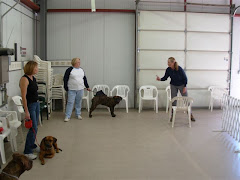David and his wife are senior citizens. They're considering re-homing their young Lab because he's "overly affectionate" and bumps them around in their small home.
Kay and her husband Dick think their female border collie needs psychotropic meds because she's so destructive and bratty in their large old home, located in a downtown area.
Shelters, meds, and behavior modification training are seldom the answer. Every one of the above-mentioned dogs could be reformed--yes, even the urban border collie--if the owners provided just one thing for them:
ADEQUATE EXERCISE
Let's define some terms:
- "EXERCISE": prolonged physical activity that elevates the heart rate to a level that can be safely and beneficially sustained for 20-40 minutes. Examples: brisk walking or running, with no stops that would slow down heart and respiratory rates. For dogs, that means leash-walking at the owner's sustained pace, swimming, playing frisbee, safely accompanying moving objects like horses and bicycles, or spending the time on an indoor treadmill.
- "ADEQUATE": an amount of exercise that will tire your dog. At the end of such activity, he should be glad for the opportunity to lie down and rest. For an old dog with arthritis, that may mean a trip to the mailbox. For a young healthy dog it could mean going for a six-mile run with you. Read your dog, taking into account his age, physical condition, and the weather.
Good news: Most dogs, since they're grossly underexercised to begin with, can benefit greatly from short exercise sessions of 15-20 minutes.
Bad news: As your dog gets into better shape, he will require more exercise to maintain or improve his condition.
 How this helps behavior problems: Dogs are bundles of energy, which must be expended one way or another if the dog is to stay sane. Fortunate dogs (those with good owners) expend this energy on daily leash walks or hikes. Less fortunate dogs (with unmotivated owners) expend the same energy digging holes in the back yard, tearing up furniture, and destroying anything they can get their teeth on in the home or yard. One way or another, the energy must be released and dissipated or it will blow, just like the lid on a pan of boiling water.
How this helps behavior problems: Dogs are bundles of energy, which must be expended one way or another if the dog is to stay sane. Fortunate dogs (those with good owners) expend this energy on daily leash walks or hikes. Less fortunate dogs (with unmotivated owners) expend the same energy digging holes in the back yard, tearing up furniture, and destroying anything they can get their teeth on in the home or yard. One way or another, the energy must be released and dissipated or it will blow, just like the lid on a pan of boiling water.A physically tired dog has a calm mind. Through physically taxing exercise, his body produces endorphins that produce a pleasurable sense of calm--a "runner's high," as they used to call it. A calm mind is able to think. It's less reactive. It's more receptive to learning. (That's why Cesar Millan, The Dog Whisperer, preaches "Exercise, Discipline, and Affection" as the dog's three basic needs, in that order.)
Which dog would you rather have? Well...it doesn't really matter. You can only have the good dog if you're willing to be the good owner.
It may seem easier to pop a mind-adjusting pill into your dog's mouth than to get up in the dark at 5:30 and take your dog for a walk. It may seem easier to let someone else fix your dog, whether that means behavior modification lessons or surrendering him to a shelter. But it's YOUR DOG. YOUR RESPONSIBILITY. If you want the dog of your dreams, instead of your nightmares, get your boots and warm clothes on, grab a leash, call your dog, and start walking.
If you won't do this....you have no right to complain!





















1 comment:
A good article...right on point. Ron
Post a Comment